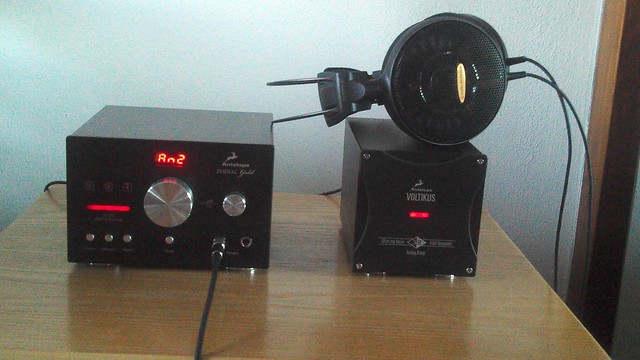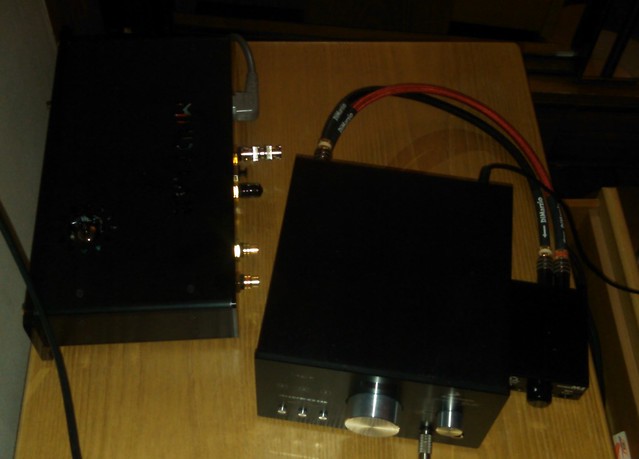The Zodiac Gold is the top of the Antelope Audio dac line. The Gold is considered an improvement over its lesser siblings because of its high quality stepped attenuator, and because of the board modifications made to use such attenuator.
There is a motor which lets the attenuator move either when commanded from the computer (through a small front end, which mimics the looks of the zodiac gold, to let the listener regulate the analogue volume through the pc), or with the remote control.
The remotely controlled stepped attenuator is for the preamplifier only, while the integrated headphone amplifier uses a smaller knob, to be regulated manually.
The DAC employs a custom-built USB chip that allows streaming audio up to 384 kHz.
The Zodiac line uses a master clock that is encapsulated in a “thermally isolated region”, which Antelope calls ‘oven’, to keep it as precise as possible. Jitter management is handled by the proprietary Acoustically Focused Clocking technology (AFC), implemented in all Antelope’s professional master clocks.
At the time of this review, the latest firmware update brought the Asynchronous jitter rejection mode to the USB.
UPDATE: DSD support was scheduled for the first quarter of 2013, with a firmware upgrade. On 2013/05/30, Antelope Audio unveiled Zodiac Platinum DAC with DSD support, and I am not sure that the Zodiac Gold will be upgraded to support DSD anymore.
The Zodiac Gold is a connectivity monster, given it can work as a usb transport for other dac’s (through the coax and bnc digital outputs), it can act as a balanced and single ended preamplifier, headphone amplifier, and dac only.
Design
I have purchased a black Zodiac Gold + Voltiks combo, as it’s by far my favourite colour for hifi gear. I think the Zodiac Gold, especially with black colour is very elegant, and I especially like the small footprint of both units.

Sound
The Zodiac Gold implements Burr Brown PCM1792 chips in a different way than several other DAC’s based on the same family, by strongly integrating the chips with the temperature controlled oscillator and the proprietary AFC.
Unlike other DAC’s, based on the same chip family (like the Eximus DP1, the Neko, the Ayre QB9), which tend to share the same warmish, fluid tonality, the Zodiac Gold provides an extremely flat presentation. Unlike the Eximus DP1, which has prominent upper midrange, slightly accentuated midbass, and smooth treble, the Zodiac Gold has much more impactful, deeper, but more precise bass, very linear midrange, and slightly harder treble than the DP1.
These differences can do a lot when using specific headphones. My Audio-Technica AD2000, when listened with the Zodiac Gold dac/amp, have surprising bass impact, a dry presentation in the low midrange, and a certain exaggeration from upper midrange to treble.
These are headphones that enjoy particularly warm sources. When used with the DP1, bass was less impactful, highs were smoother, but midrange was too hot.
I obtained the same sonic results when using the Zodiac Gold as a preamp into my tiny Headamp AE2. Such tiny amp works very well in combination with the AD2000, it’s very neutral, transparent and powerful for the size, and the AD2000 are among the most efficient low impedance headphones.
I have been listening also to two different Stax SRS001 Mk2 setups, both modified, differently, from Audiocats; I have then used the Zodiac Gold with my Stax SRM-727A and Gamma Pro. In both cases, I believe that Stax have a special affinity with the Zodiac Gold, mostly because of their inherent smoothness (just like ribbon tweeters), combined with their resolving power.
While, for example, the Gamma Pro have a peak in the highs, there weren’t any tracks of plastickyness in the sound, which I instead detected with the AD2000. The two Babystax setups, based on the SR-001 Mk2 in-eaespeaker, are vouched differently in order to extract more treble (one amplifier), and a warmer midbass/lower midrange balance with more subdued highs (the other). In both cases, the music flow was still natural, despite the first setup was showing much treble energy and detail.
All these Stax headphones also have quite prominent midrange (just like the Lambda series would have), mating quite well with the linear midrange of the Antelope dac.

I have also used the SRM727A in direct mode (as a power amp, bypassing its own volume knob), and the Zodiac Gold as a preamplifier with the stepped attenuator. I must admit I didn’t hear an appreciable difference in sound, but I could gain the ability to control the volume remotely (either from the dac’s own remote or computer).
While other manufacturers tend to voice dac’s trying to call them ‘analogue’, and falling short 90% of the time (they still sound like great dac’s, but analogue is a whole different thing), the Antelope is vouched to be a monitor dac; additional warmth, if necessary, needs to be provided at later stages: either amplification (tubes if using fast sounding dynamic headphones like Audio Technica AD2000 or Grado’s), or headphones, as shown with Stax using my solid state amplifiers. I’d be curious to listen to Sennheiser HD600 through the integrated amp.
I don’t think that using third party USB interfaces (such as Audiophilleo 2) makes a noticeable difference compared to the USB input of the Zodiac Gold + Voltikus. The sound signature stays the same and the level of details and imaging stays top notch.
I have used the Zodiac Gold as a USB transport for my Museatex Idat-44 Mobile with a Belkin Synapse digital interconnect; while the sound signature was slightly different compared to feeding the Idat44 with Audiophilleo 2, with a slightly bloomier upper bass response and texture and a bit more treble, it’s not easy to separate the contribution of the Antelope coax output from that of the Belkin Synapse inherent character, which itself has a bassier presentation and quite relaxed midrange compared to several digital cables.
Conclusion
With the possible exception of Eximus DP-1, I consider the Zodiac Gold the most detailed DAC I have owned. While the Eximus projects the music towards the listener and provides stronger midrange conveyal, the Zodiac Gold DAC is able to provide a more powerful and tighter bass foundation, and keeps the soundscape dense and involving.
Both the two dac’s offer preamplification capabilities, and both offer a headphone amp which is basically “more of the same”. I think in both cases, the headphone amp is an average addition to a great sounding dac.
In the case of the more expensive Zodiac Gold + Voltikus, a buyer is both looking for a monitor tonality and is also paying for the remotely controlled analogue amplification, which works very well and has something addicting.
In the case of the Eximus DP1, a person is looking for a very liquid tonality, which, while already very pleasing, will impact on the choice of the other components.
In both cases, I think Dac, Usb reception and preamplification are very good, while exploiting the headphone amp requires to find headphones that match well the solid state components used.



